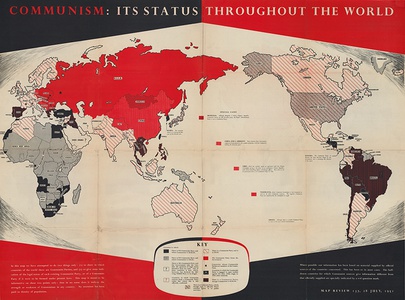| Method | Chromolithograph |
| Artist | The Bureau of Current Affairs |
| Published | Map Review 137, 28 July, 1951. Map Review is Produced Fortnightly by The Bureau of Current Affairs, 117 Piccadilly , W.I. Subscription 30/- Per Annum. 1/6 Per Copy Post Free. Printed by Fosh & Cross Ltd. London. |
| Dimensions | 755 x 1005 mm |
| Notes |
A large and colourful infographic map of the world, outlining the status of Communism, published by The Bureau of Current Affairs in July 1951, at the height of the McCarthy Era and the Second Red Scare. The poster, number 137 in the Map Review series published by the BCA, features a stylized world map, essentially a Mercator Projection in a hexagonal border, colour coded in various shades and patterns of red, grey, and black to represent the level of communist involvement in various governments across the globe at this critical stage of the Cold War. A large oval key at the bottom centre of the map explains the design. Countries where the Communist Party forms government are coloured in solid red, the most conspicuous obviously being the USSR, and the various Soviet backed nations of eastern Europe. China and East Germany are excluded from this designation on the technicality that they both have representatives of other parties in government, though all positions of importance are held by communists. Nations where communism is legal and where parties have been established, are striped in red. Grey countries, mostly confined to Africa, are nations where communism is legal, though there is no active party. On the other end of the political spectrum are nations coloured in black, where communism is officially illegal, though those where parties are active regardless are striped in red. Where the status of nations is unknown, or there is conflicting evidence either way, a question mark is used. The final category, encompassing Japan and the United States, is the best indicator of the dubious governmental position brought about by McCarthyism: 'There is a Communist Party, which, though legal, is officially discriminated against in its public activities.' A number of other special cases are also presented: Mongolia, which despite being a 'People's Republic,' is not recognised as communist, Tibet, an autonomous Chinese Republic but without its own Communist Party, Yugoslavia, expelled from the Cominform in 1948, and Greece, where the Communist Party is mainly active outside the nation itself. In addition to the official designations, the map also features other details relevant to the impact and spread of communism globally. Members of the Cominform are marked with black stars, the active conflicts in Indochina and Malaya are marked with crossed swords, and the Korean peninsula is divided according to the situation as it was in the first year of the Korean War. The BCA, itself often accused of being under communist influence or sympathetic to its aims, takes great pains to declare its intentions for the map as being solely to inform, free of any inherent bias for or against. A large descriptive text in the bottom left reads: 'In this map we have attempted to do two things only: (1) to show in which countries of the world there are Communist Parties, and (2) to give some indication of the legal status of each existing Communist Party, or of a Communist Party if it were to be formed under present laws. This map is meant to be informative on these two points only: thus in no sense does it indicate the strength or weakness of Communism in any country. No attention has been paid to density of population.' In the bottom right, the Bureau cites its sources: 'Where possible our information has been based on material supplied by official sources of the countries concerned. This has been so in most cases. The half-dozen countries for which Communist sources give information different from that officially supplied are specially indicated by a red question mark.' The Bureau of Current Affairs was a peacetime continuation of the Army Bureau of Current Affairs, set up in 1940 following the advice of Dr Tom Jones, the celebrated educationalist, civil servant, and chairman of the Gregynog Press. The ABCA's principal aim was to provide service men and women with mental stimulation and knowledge of current events, through the publication of regular pamphlets, posters, and other educational material, as well as the facilitation of talks, classes, and discussion groups. Management of the Bureau was placed in the hands of Jones' protege, Sir William Emrys Williams, who was already well-known as a leading proponent of lifelong learning, having served before the war as Secretary of the British Institute of Adult Education and as editor-in-chief of Penguin Books. Despite vocal criticism from a number of influential figures, including Churchill, who saw the Bureau as a waste of public funds, the ABCA, with support from the Carnegie Trust, continued after the war as the Bureau of Current Affairs, championing the welfare and social aspirations of Attlee's Labour government. Condition: Pressed vertical and horizontal folds, as issued. Tears, creases, and abrasion to folds. Repaired chips and splitting to some folds. Blank on verso. |
| Framing | framed |
| Price | £950.00 |
| Stock ID | 53495 |

